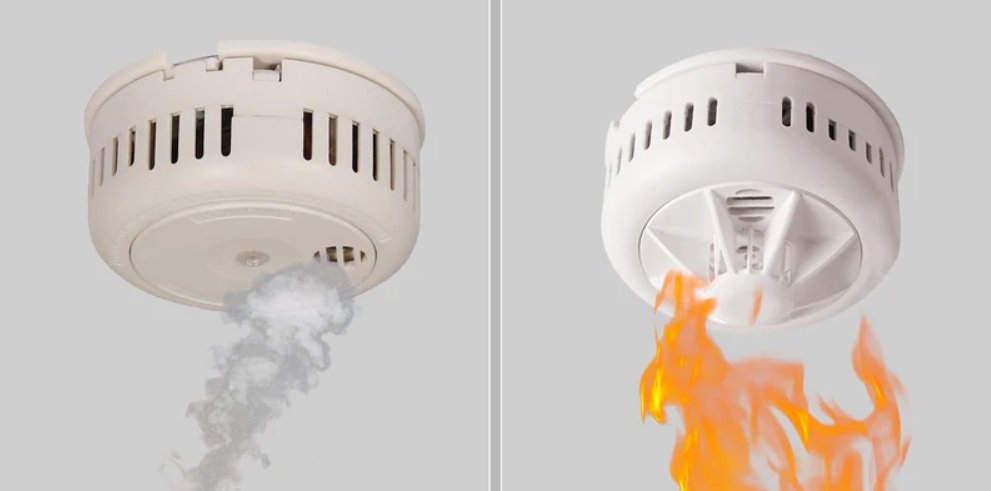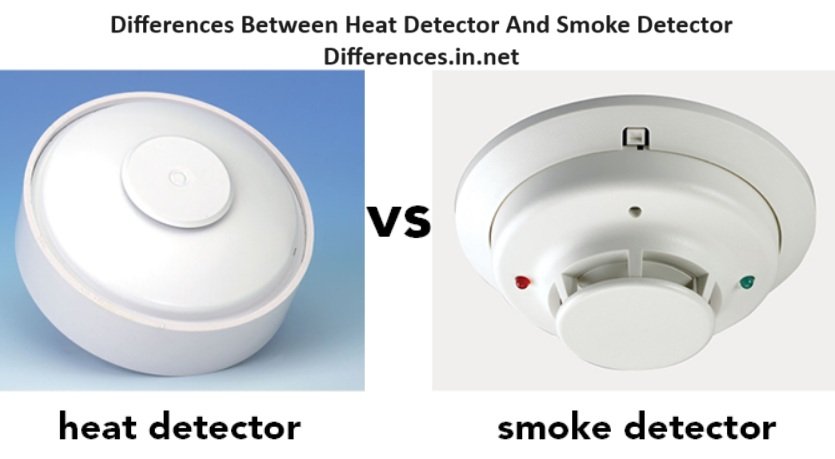Understanding Heat and Smoke Detectors
Although heat and smoke detectors serve distinct functions, both are vital components of a fire alarm system. A heat detector detects temperature variations, particularly a sudden rise in heat, which could indicate a fire. This type of detector is ideal for areas like kitchens or garages, where smoke or other pollutants often occur.
In contrast, a smoke detector identifies smoke particles in the air, typically a sign of a fire. Smoke detectors are usually placed in areas like bedrooms or living rooms, where smoke often serves as the first warning of a fire.
The Functionality of Heat Detectors
A heat detector functions by detecting a significant rise in temperature, often above a specific threshold. This means that in the early stages of a fire, when smoke is present before a noticeable increase in temperature, a heat detector may not be as sensitive as a smoke detector. Smoke detectors, however, are highly sensitive to smoke particles and can detect a fire before any noticeable temperature rise occurs. Therefore, smoke detectors are more effective at providing early fire warnings.
Strategic Placement and Operation of Detectors
Heat detectors are typically placed in areas where smoke detectors would be unsuitable, such as kitchens or garages, where smoke or other odours are common. Smoke detectors, on the other hand, are usually installed in spaces like living rooms and bedrooms, where smoke is often the first sign of a fire.
To ensure complete coverage and early detection of fires, a fire alarm system must include both heat and smoke detectors. Understanding the differences between these two types of detectors helps you choose the right location and operation for your fire alarm system.
An Overview of Fire Safety Systems
Fire detection systems are crucial in homes, businesses, and industrial settings for maintaining safety and minimising damage. The early warning capabilities of these devices enable prompt evacuation and action during a fire. Early fire detection is essential, as it significantly increases the chances of saving lives and protecting property. According to the National Fire Protection Association (NFPA), effective fire detection equipment can reduce property damage and cut the chance of fatalities by over 50%.
The Importance of Heat and Smoke Detectors
Among the various components of fire detection systems, heat detectors and smoke detectors are the most important. Heat detectors detect significant rises in temperature, indicating the presence of a fire. These detectors are particularly effective in kitchens and garages, where smoke detectors might cause false alarms.
Smoke detectors, however, are designed to detect smoke particles, which are often one of the first signs of a fire. These detectors are essential in residential settings, as they can quickly identify smoke and give residents critical time to evacuate safely.
 Enhancing Fire Safety Preparedness
Enhancing Fire Safety Preparedness
To clarify the distinctions between smoke and heat detectors, we aim to provide readers with a thorough understanding of the operation and recommended uses of each type. By exploring these technologies, we hope to equip readers with the knowledge they need to make informed decisions about their fire safety measures. Regardless of whether you are a homeowner, business owner, or industrial facility manager, understanding the differences between heat and smoke detectors can improve your fire safety plan.
Understanding Heat Detector Operation
Heat detectors are essential components of fire detection systems, designed to respond to temperature changes rather than smoke. These detectors come in two primary types: rate-of-rise and fixed temperature. Each type has its own method for detecting potential fires and activating alarms.
Fixed-Temperature Heat Detectors
Fixed-temperature heat detectors trigger an alert when the temperature in a room surpasses a predetermined threshold. This threshold is usually set between 135 and 190 degrees Fahrenheit. The sensing device, often made of thermocouples or eutectic alloys, shuts off an electrical circuit when the temperature exceeds this threshold, activating the alarm system.
Rate-of-Rise Heat Detectors
Rate-of-rise heat detectors are designed to detect rapid increases in temperature. These detectors monitor the rate at which the surrounding air temperature rises and trigger an alert when it exceeds a set threshold, typically 15 degrees Fahrenheit per minute. This process enables them to detect fires faster than stationary temperature detectors, especially in situations where the temperature increases quickly.
Strategic Use of Heat Detectors
In some locations, smoke detectors may not be suitable due to the risk of false alarms. In these cases, heat detectors are highly useful. For example, smoke detectors may trigger false alarms in areas with high steam, dust, or airborne particles. Heat detectors are reliable alternatives in these situations. Common applications include boiler rooms, where high temperatures and dust are prevalent, and kitchens, where cooking operations often produce smoke and steam. In these environments, heat detectors are advantageous as they focus on temperature changes and ignore particles unrelated to fire.
Smoke Detector Functions
Smoke detectors are essential parts of any fire protection system. They detect the presence of smoke and warn users of potential fire risks. Smoke detectors use various methods to detect smoke particles. The three primary types are ionisation, photoelectric, and dual-sensor detectors, each employing a different technique to detect smoke.
Ionisation Smoke Detectors
Ionisation smoke detectors are highly sensitive to small smoke particles, which are often produced by fast-spreading fires. These detectors ionise the air and generate a current by placing a small amount of radioactive material between two electrically charged plates. Smoke entering the chamber interferes with this process, reducing the current and triggering the alarm. Ionisation detectors are effective at detecting fast-flaming fires but may not be as sensitive to smouldering, slow-burning fires.
Photoelectric Smoke Detectors
Photoelectric smoke detectors are particularly good at detecting larger smoke particles, which are typically produced by smouldering fires. These detectors feature a right-angled light source and a light-sensitive sensor. When smoke enters the chamber, it scatters the light, hitting the sensor and activating the alarm. Photoelectric detectors are ideal for detecting slow-burning fires, as they respond more quickly than ionisation detectors.
Dual-Sensor Smoke Detectors
Dual-sensor smoke detectors combine both ionisation and photoelectric technologies, offering comprehensive protection against different types of fires. These detectors provide a balanced approach to fire detection by identifying both smouldering and fast-flaming fires. Although dual-sensor detectors are generally more expensive, many businesses and households prefer them due to their superior detection capabilities and versatility.
Strategic Placement and Operation of Smoke Detectors
Smoke detectors perform best in areas such as living rooms, bedrooms, and corridors, where early fire detection is crucial. For instance, a photoelectric detector in a corridor can quickly identify smouldering smoke from a slow-burning fire, giving residents more time to evacuate. In kitchens, an ionisation detector may be more suitable for detecting a quickly spreading grease fire. By strategically placing smoke detectors, you can ensure timely detection and response to a variety of fire situations, enhancing safety.
Important Distinctions and Selecting the Proper Detector
A successful fire detection strategy requires understanding the differences between smoke and heat detectors. Heat detectors respond to the heat produced by a fire. Although they activate more slowly than smoke detectors, they are less likely to cause false alarms due to activities like cooking or steaming that are not related to fires. Therefore, heat detectors are particularly useful in environments like kitchens and garages, where such activities are common.
Choosing Between Smoke and Heat Detectors
Smoke detectors, in contrast, provide early fire warnings due to their sensitivity to smoke particles. While they can detect fires more quickly than heat detectors, they are prone to false alarms caused by cooking smoke, steam, or dust. Smoke detectors are typically recommended in living spaces, bedrooms, and corridors, where quick fire detection is essential for safe evacuation.
Considering Environmental Factors
Several factors should be considered when deciding between smoke and heat detectors. The specific environment plays a crucial role. Heat detectors may be more suitable for areas with high dust, humidity, or cooking odours. On the other hand, smoke detectors are more effective in spaces like living rooms and bedrooms, where quick fire detection is critical.
Optimising Fire Detection Systems
To create a comprehensive fire detection strategy, it is generally advisable to use both smoke and heat detectors. This approach minimises the risk of false alarms while maximising safety by ensuring that various types of fires are detected promptly and accurately.
Choosing the right detectors based on the specific needs of each environment and regularly testing and maintaining the fire detection systems are key to successful fire safety. Using a combination of detectors ensures that the fire detection system remains sensitive and reliable, providing the best protection against fire hazards.
Table of Differences between Heat Detector and Smoke Detectors
| Characteristic | Heat Detector | Smoke Detector |
|---|---|---|
| Function | Detects rapid temperature rise or high heat | Detects presence of smoke particles in the air |
| Trigger | Activated by significant increase in temperature | Activated by presence of smoke or combustion particles |
| Installation Location | Typically installed in areas prone to rapid temperature rise or high heat, such as kitchens or boiler rooms | Installed in various locations throughout a building, such as hallways, bedrooms, and living areas |
| Sensitivity | Less prone to false alarms caused by dust or steam | Can be triggered by non-threatening sources like cooking smoke or steam |
| Response Time | Activates when a preset temperature threshold is reached | Activates when smoke particles reach the sensor |
| Usage | Often used in areas where smoke detectors may not be suitable, such as kitchens or garages | Commonly used in residential and commercial buildings to provide early warning of fire |
| Types | Fixed temperature heat detectors, rate-of-rise heat detectors | Ionisation smoke detectors, photoelectric smoke detectors, and dual-sensor smoke detectors |
| Power Source | Battery-powered or hardwired to the building’s electrical system | Typically powered by batteries or hardwired into the building’s electrical system |
| Cost | Usually more expensive than smoke detectors | Generally less expensive than heat detectors |
| Maintenance | Requires less maintenance and testing compared to smoke detectors | May require periodic cleaning and testing to ensure proper function |


